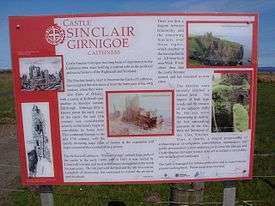Battle of Altimarlach
| Battle of Altimarlach | |||||||
|---|---|---|---|---|---|---|---|
| Part of the Scottish clan wars | |||||||
  Coats of Arms of Campbell, Earl of Breadalbane (left) and Sinclair, Earl of Caithness (right) | |||||||
| |||||||
| Belligerents | |||||||
| Clan Campbell | Clan Sinclair | ||||||
| Commanders and leaders | |||||||
| Sir John Campbell | George Sinclair of Keiss | ||||||
| Strength | |||||||
| 800 | 500 | ||||||
| Casualties and losses | |||||||
| very low | 300 | ||||||

The Battle of Altimarlach or Battle of Altimarlech was a Scottish clan battle that took place on 13 July 1680. It was fought between the Clan Campbell and Clan Sinclair.[1]
Background
In 1672, debt forced George Sinclair, 6th Earl of Caithness, to resign his titles and estates in favour of Sir John Campbell. Campbell took possession of the estates on Sinclair's death in May 1676, and was created earl of Caithness in June the following year. Sinclair's heir, George Sinclair of Keiss disputed the claim and seized the land in 1678.[1]
Battle
On 13 July 1680, Campbell took a force of 800 men north to evict Sinclair of Keiss, who was waiting for him with 500 men near Wick. Inflamed with drink, the Sinclairs attacked the force of Campbells and were routed. Legend has it that so many Sinclairs were killed that the Campbells were able to cross the river without getting their feet wet.[1][2]
The Campbells' piper composed a tune before the battle, whose English translation is "Gaffers in Trousers". This was meant to taunt the Sinclairs who, unlike the Campbells who wore kilted Highland dress, wore tartan trews.
Aftermath
Having failed to regain his inheritance by force, Sinclair of Keiss then turned to the law. He took his place as Earl of Caithness on 15 July 1681, and his lands were restored on 23 September. Campbell was made Earl of Breadalbane by way of compensation.[1]
Ballad
A ballad commemorating the battle was first published in 1887 in a book by historian James Traill Calder:[3]
The Battle of Altimarlach: A Ballad
’Twas morn; from rustic cot and grange
The cock’s shrill clarion rung;
And fresh on every sweet wild flower
The pearly dew-drop hung.
Given up to thoughtless revelry,
In Wick lay Sinclair’s band,
When suddenly the cry arose,
”Glenorchy’s close at hand!”
For now the Campbell’s haughty chief
The river Wick had crossed,
With twice seven hundred Highlanders
A fierce and lawless host.
”To arms! To arms!” from street to lane
The summons fast did go;
And forth the gathered Sinclairs marched
To meet the coming foe.
Where Altimarlach opens up
Its narrow, deep ravine,
Glenorchy’s force, in order ranged,
Were strongly posted seen.
They meet, they close in deadly strife,
But brief the bloody fray;
Before the Campbell’s furious charge
The Caithness ranks gave way.
Flushed with success, Glenorchy’s men
Set up a savage cheer,
And drove the sinclairs panic-struck
Into the river near.
There, ‘neath the Cambell’s ruthless blade
Fell more than on the plain,
Until the blood-dyed stream across
Was choked up with the slain.
But who might paint the flood of grief
That burst from young and old,
When to the slaughtered Sinclair’s friends
The direful tale was told!
The shrieking mother wrung her hands,
The maiden tore her hair,
And ll was lamentation loud,
And terror, and despair.
Short time Glenorchy Caithness ruled,
By every rank abhorred;
He lost the title he usurped,
Then fled across the Ord.
While Keiss, who firm upheld his claim
Against tyrannic might,
Obtained the Sinclair’s coronet
Which was his own by right;
The coronet which William wore,
Who loved his Prince so well,
And with his brave devoted band
On fatal Flodden fell.
References
- 1 2 3 4 Anderson, William (1862), The Scottish nation: or, The surnames, families, literature, honours, and biographical history of the people of Scotland, Fullarton, pp. 524–5
- ↑ Way, George and Squire, Romily. Collins Scottish Clan & Family Encyclopedia. (Foreword by The Rt Hon. The Earl of Elgin KT, Convenor, The Standing Council of Scottish Chiefs). Published in 1994. Pages 322 - 323.
- ↑ Calder, James Traill (1887). Sketch of the Civil and Traditional History of Caithness from the Tenth Century. Wick. p. 309. Retrieved 4 February 2017.